

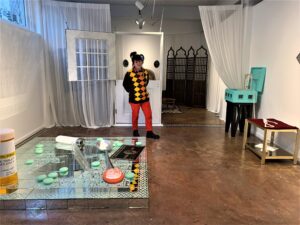
“Born of our Culture: American Excess” a recent installation at Method Gallery by Morgan Peterson tells it like it is in our contemporary moment. Morgan Petersen has long been fascinated by true crime and the amplifying role that media plays in our culture starting with the 1969 Charles Manson murders
My fascination with true crime began as a small child reading about the Tate/Labianca murders committed by the Manson Family Cult late in the evening on August 8,1969. This installation mirrors events that transpired that evening which captured the attention of the world as they unfolded while revealing the driving forces of racial discrimination and profiling that repeat throughout history.
She interweaves references to media hyped events with her commentary on the American culture of Excess. It could not be more timely in the age of the insanely overpriced and climate destroying NFT and bitcoins.
The exhibition actually consists of three interrelated installations:
we first see a giant reflective glass surface with oversized components of drugs and their use referencing the opioid epidemic. A huge bottle of oxycontin makes it hard to miss the point. Here is
Once Upon A Crime, The American Epidemic
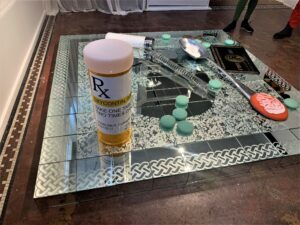
The epidemic is based in greed:
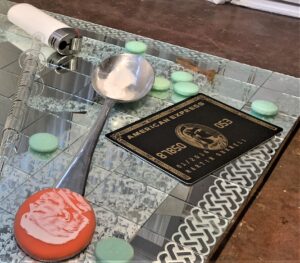
the installation specifically references Martin Shkreli on the credit card who raised the price of life saving drugs from 13. to 750. per pill.
Peterson also comments on excess more subtly in the pattern of the glass surface. It is based on the cover of an album which the artist describes as “the most expensive album ever sold, Once Upon A Time In Shaolin . . . This piece speaks of the overreaching power in politics, being born with a silver spoon in your mouth, the opioid epidemic and all over corruption.”
A second installation features Black Panther leader Huey P. Newton’s iconic Emmanuel chair.
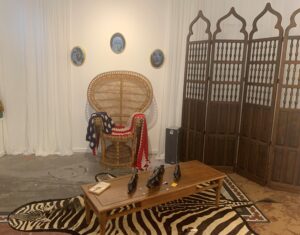
It refers to Black Panther Fred Hampton’s horrific murder by police just after Charles Manson’s effort to link Black Panthers to multiple murders by his cult members in 1969 in order to start a race riot. The Charles Manson cult murders of Sharon Tate, Jay Sebring, Abigail Folger, Wojciech Frykowski, Steven Parent, Leno and Rosemary LaBianca were followed shortly after by Fred Hampton’s assassination by the police, and twenty years later by Newton’s murder.
Newton and Hampton were both brilliant founders and spokespersons for the Black Panthers. Their programs such as “giving breakfast to children and creating alliances among street gangs, food banks, medical clinics, sickle cell anemia tests, prison busing for families of inmates, legal advice seminars, clothing banks, housing cooperatives, and their own ambulance service” were incredibly successful which is why the FBI decided they were terrorists. They were disrupting the capitalist machine and the racist oppressions that keep it running.
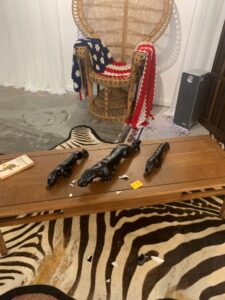
Morgan Peterson honors their deaths with this installation which includes specific vintage furniture and props from the 1960s that she carefully located. On the coffee table you see a book and matchbox precisely recreating the scene of the murder of Hampton. The stone sculptures of the Black Panthers suggest by their small scale, the oppression of our dominant gaze
A third installation refers to our very present moment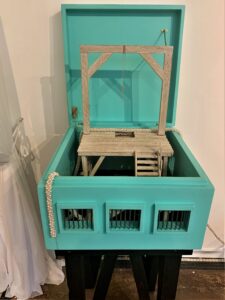
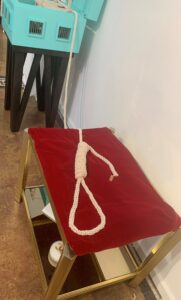
This carefully constructed wooden gallows with its lynch noose made of 11000 small pearls woven by the artist in a special Russian spiral stitch, speaks for itself. The horror of our January 6 attempted coup, as well as the role of greed in racism in our country is spelled out here.
( The artist bought the pearls with the stimulus check from the government during the pandemic. She made the work in collaboration with wood working master Alexander Pope.)
Peterson speaks to the current insanity of our country, the thirst for power at all costs.
Peterson was trained as a glass artist, and glass is prominent in several elements of the exhibition. But these glass works move way beyond any traditional idea of glass. The simplicity and familiarity of the material belies the complexity of the technique needed to create art with it and as a material that can speak to political issues.
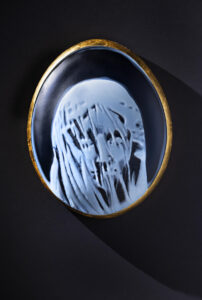
Photo Credit Russell Johnson
Above the Emmanuel Chair are three glass engraved cameos, two are portraits of people murdered by Manson.
Morgan honors these people with so called cameo “mourning portraits.” The third cameo is a specific image of mourning, a quote from a sculpture of a veiled virgin.
Cameos are demanding to create: they are based on reductively carving away a glass layer to reveal what is underneath.
Paula Stokes, a founder of Method gallery, suggests in a fascinating interview with Peterson that carving away of the surface reveals imagery underneath that can become sinister.
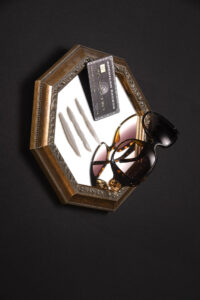
One other group of works in the exhibitions using mirrors and various luxury accouterments refer to cocaine use by the wealthy.
The intertwining of the rich use of cocaine, the opioid epidemic, and the overpricing of life saving drugs, lead directly to the pearl encrusted noose held in the hands of those in power to entrap and destroy the powerless.
The Black Panthers were taking power from the ruling class and therefore had to be stopped. We can draw a straight line from them to the present moment.
Embedded in both history and the present moment, “Born of our Culture: American Excess” suggests the true state of our world, in the massive disparity between the practices of those who control power and will murder those who threaten it, and those who seek simply to survive day to day.
As Ann Applebaum wrote in a recent article in the Atlantic, “The Bad Guys are Winning,” the big shift is the level of impunity with which the wealthy now operate. Autocracy operates across national lines and with absolute disregard for the well being of individuals.
Also explaining the depth of our problem is Sarah Chayes book
On Corruption in America and What is At Stake.
Chayes speaks of the many headed Hydra of greed , when you cut off one head another grows, and she traces greed in her book all the way back with Midas. She and Applebaum both point to the intersections of autocracies and kleptocracies, as a network that ensures their own survival above all else.
Likewise Morgan Peterson addresses the hydra of greed is this compelling group of installations. But she connects the dots right to the racism that underlies greed, as well as its outcome in assassination and lynching.